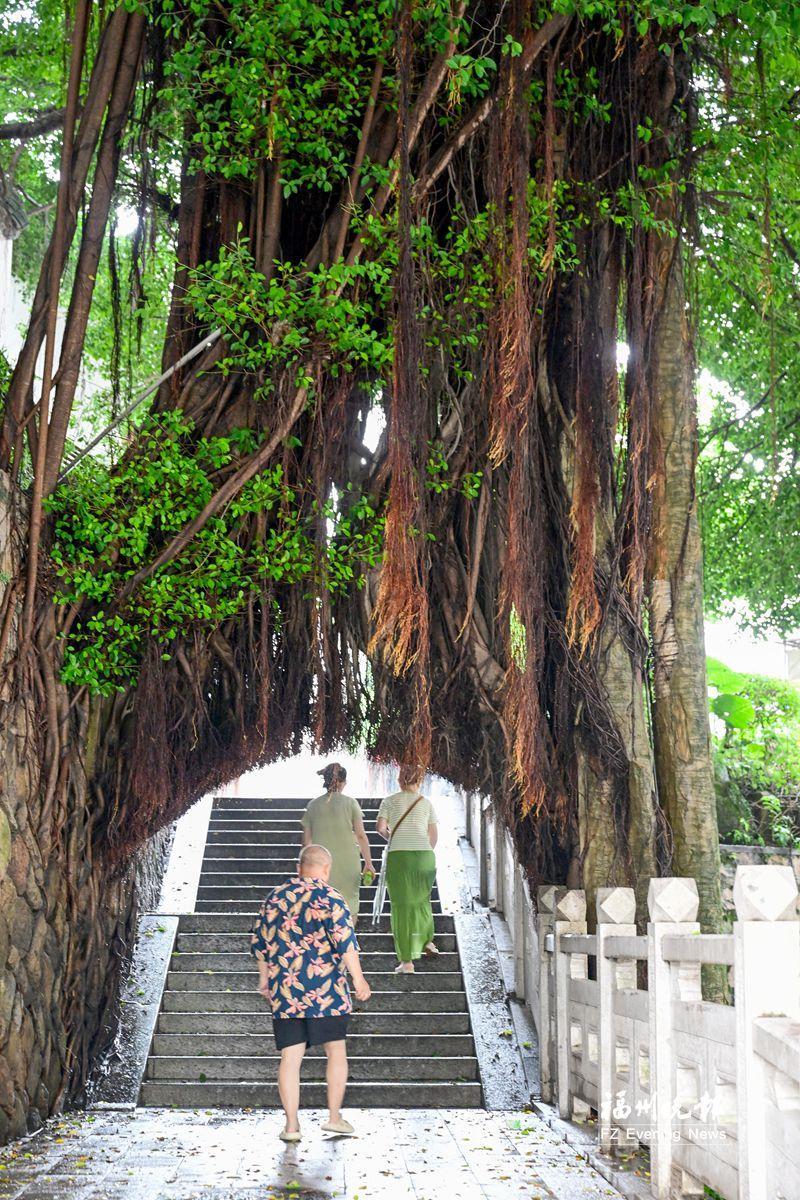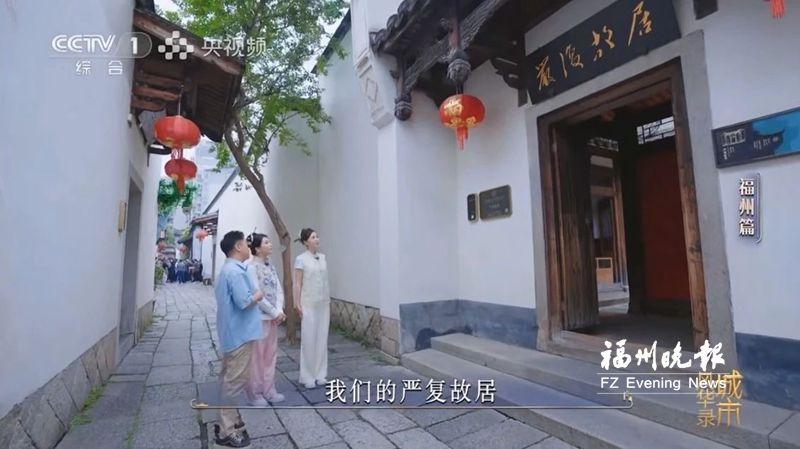CCTV’s City Stories Fuzhou Episode Premieres “City Stories Team” Exploring the Charm of Fuzhou

Visitors were taking photos with the “Love Tree” in Sanfang Qixiang
On the evening of June 7, CCTV-1 premiered the Fuzhou episode of its popular seasonal series City Stories. Hosts Zhu Guangquan and Zhang Shuyue joined forces with Fuzhou University professor Wang Wenkui and actress Liu Tao to form the “City Stories Team”, setting off on a vibrant journey to explore the rich landscapes and unique flavors of Fuzhou.
Exploring the Secrets of the Banyan Tree
The “Curtain Banyan” drapes thousands of aerial roots, weaving a natural curtain; the “Shouyan Banyan” wraps its roots around a longevity stone, preserving the celebrations of the Daoguang era; the “China Tower Banyan” has stood sentinel beside Luoxing Tower for over a century, guiding boats along their way; and the “Shuangpao Lovers’ Banyans” tenderly intertwines in a narrow alley, creating a real-life scene of affection… Following the trail of over 1,000 distinctive parks, the “City Stories Team” sets out to uncover the secrets of these majestic banyan trees.
Planting banyan trees has long been a beloved tradition among the people of Fuzhou, passed down through generations. Dating back to the Tang and Song dynasties, banyans were widely cultivated throughout the city. Prominent officials like Wang Kui, Cai Xiang, and Cheng Shimeng all championed the planting of banyans during their terms in office. The tradition was further promoted in the Northern Song dynasty by Zhang Boyu, who introduced the “Household Banyan Planting” policy, encouraging and guiding the public to plant banyan trees extensively.
Statistics show that downtown Fuzhou is home to over 160,000 banyan trees, nearly a thousand of which are over a century old. Over the years, Fuzhou has not only seamlessly integrated parks into its urban landscape but also brought the benefits of its natural scenery and ecological environment directly to its residents. By embracing innovations such as “digital technology combined with landscaping,” Fuzhou has furthered its vision of becoming the “City of a Thousand Parks.” This strong connection between the city and its people is a key reason why Fuzhou has repeatedly been honored as a National Civilized City.
The first to make an appearance in the show is a banyan tree with a distinctive shape and a knack for “splitting” its roots like no other. Located in the Wushan Scenic Area, this banyan tree is known as the “Curtain Banyan” because thousands of its aerial roots cascade down, forming a natural curtain. Today, it stands as a signature landmark of the park.
Next up is the Shouyan Banyan, nestled in the Yushan Scenic Area. Its distinctive shape looks like it is embracing the rock beside it. According to legend, in 1836, the 16th year of the Daoguang reign, a grand banquet was held here in honor of the banyan’s longevity. The character “寿” (longevity), inscribed in a running script and measuring 2.22 meters across, was carved into the rock face—giving the tree its name, Shouyan Banyan.
The “China Tower Banyan” stands in Mawei, where it has accompanied Luoxing Tower for more than a century. Legend has it that a hundred or two hundred years ago, sailors would spot the tower rising from the hilltop and shout, “China Tower!” when foreign ships approached the waters off Mawei. The tower they saw was the now-famous Luoxing Tower. Growing beside it, this ancient banyan became known as the “China Tower Banyan,” and today it ranks among Fuzhou’s top ten ancient banyan trees.

The “Curtain Banyan” in the Wushan Scenic Area.
The show also spotlights the “Shuangpao Lovers’ Banyans,” two trees that have grown together, creating a romantic scene in a small alley. Legend has it that long ago, a young couple vowed to marry, but their love was thwarted by feudal customs. In despair, they leaped together into the river from Shuangpao Bridge. After their passing, two banyan trees sprouted on opposite banks, their branches gradually reaching across the water until they entwined. Though it remains a legend, the striking image of the “Lovers’ Banyans” has earned them a reputation as the most romantic of Fuzhou’s ancient banyans, now a beloved spot for couples to celebrate their love.
Fuzhou boasts many banyan trees with distinctive shapes. In Sanfang Qixiang, one banyan is affectionately called the “Love Tree” for its heart-shaped form. This tree has attracted coverage from major media outlets such as People’s Daily and huanqiu.com and has frequently appeared on Weibo’s local trending searches.
In Fuzhou National Forest Park stands an ancient banyan tree, said to have been planted nearly a thousand years ago during Zhang Boyu’s initiative to promote banyan cultivation. Its trunk measures around 10 meters in circumference—large enough for six people to encircle with their arms. Towering about 20 meters tall, its broad canopy covers 1,330 square meters, offering cool shade for up to a thousand people.
There is also an ancient banyan tree in Nanmendou. During the construction of the transfer station for Metro Line 1 and Line 2, Fuzhou even had the subway route adjusted to protect this “landmark banyan.”
The ancient banyan at the Hualin Road roundabout is believed to have been planted during the Northern Song dynasty when the Hualin Temple was built. In 1986, during a road expansion, the tree was moved to the center of the roundabout. Today, this majestic tree still stands proudly in the middle of Hualin Road, its sprawling canopy offering shade like a massive green umbrella.

The “City Stories Team” visited Sanfang Qixiang. (Video screenshot)
Exploring the “Roots and Soul” of Fuzhou
A single central axis offers a window into the essence of Fuzhou. Along this cultural journey, members of the “City Stories Team” visited the “Love Tree” in Sanfang Qixiang—a symbolic stop that reflects the city’s deep roots and enduring spirit. From there, the team split into two groups: Zhu Guangquan and Wang Wenkui explored the path of architectural preservation, while Zhang Shuyue, Liu Tao, and guide Zheng Xian followed a route highlighting the revitalization of Fuzhou’s cultural heritage.
In the Fuzhou dialect, “gucuo” broadly refers to ancient buildings. Sanfang Qixiang, famed for its dense collection of these ancient structures, vividly showcases the rich cultural heritage of Southeast China during the Ming and Qing dynasties. From urban planning and architectural craftsmanship to its deep-rooted human history, it offers a comprehensive glimpse into the region’s cultural legacy.
Today, urban archaeology combined with cutting-edge technologies like “drone oblique photography and 3D laser scanning” enables non-invasive, full-coverage 3D modeling of the ancient buildings in Sanfang Qixiang. This allows for restoration and digital archiving with millimeter-level precision, reflecting a shift from reactive “emergency preservation” to proactive “preventive conservation.” Whereas firewalls once served as physical barriers, the Sanfang Qixiang Fire Rescue Station—nicknamed “Flame Blue”—now utilizes intelligent fire prevention systems, boasting an impressive safety record of 14 consecutive years without a fire and 35 years free of any major incidents.
Host Zhu Guangquan said, “Every lane or alley here is steeped in rich cultural heritage and echoes with timeless stories. History comes alive, and life here is vibrant and full of passion. It’s definitely a must-visit for anyone coming to Fuzhou!”
In the show, Liu Tao and Zhang Shuyue, wearing traditional Fuzhou headpieces called “three hairpins” and dressed in classic Chinese garments, paused beneath the Love Tree on Nanhou Street as they strolled through the time-honored alleys. They visited the renowned old residences of Sanfang Qixiang, where a seasoned guide shared captivating stories about the ancient buildings.
At Lin Juemin’s Former Residence, the “City Stories Team” thoughtfully explored the exhibits, deeply moved by Lin’s heartfelt love for his wife, as expressed in A Letter to My Wife, and his profound patriotism during a time of national upheaval. Later, at the waterside theater, they enjoyed tea while watching the immersive performance Grand Banquet at the Waterside Pavilion. Designed to resonate with younger audiences, the show vividly brings ancient architectural culture to life, featuring elegant yet powerful lantern dances, the energetic Dayan dance, and the classic Min opera Switching Fairy Peach with Litchi.
A Fulfilling Journey: Immersed in Charm and Vitality
Additionally, the “City Stories Team” explored a variety of Fuzhou’s iconic landmarks and cultural sites, immersing themselves in the city’s distinctive charm and soaking up its vibrancy and vitality along the way: They strolled along the Fuway, which stretches for 1,000 li (about 500 kilometers), soaking in the tranquility and vitality of this green corridor that connects mountains, rivers, people, and city life. Along the way, they marveled at the innovative design of China’s first steel-framed suspended walkway and the harmonious coexistence of people and nature. Gliding through Fuzhou’s inner waterways, they enjoyed the leisurely charm of a boat tour, tracing the historic role of “waterways as trade routes” from West Lake to Baima River, while also witnessing the smart water management innovations of China’s first urban water system coordination center. In Guixi Community, they experienced the warmth and harmony of the “Fujian-Taiwan bond,” joined a food festival at the Cross-Strait Community Exchange Center, and saw firsthand the happy lives of Taiwan residents in Fuzhou, along with the deep-rooted ties and shared future between people on both sides of the Taiwan Strait. They also explored the China Shipyard Culture Park, where they reflected on the century-long achievements of China’s shipbuilding industry and felt the soaring spirit of the Chinese people, embodied by the mighty Fuzhou ships as they set sail with dreams and determination. (Fuzhou Evening News Reporters: Chen Muyi, Guan Shu/Text; Lin Shuangwei, Shi Meixiang/Photo)